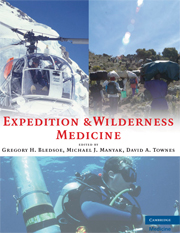Book contents
- Frontmatter
- Contents
- Contributors
- Foreword
- Preface
- Acknowledgments
- PART I EXPEDITION PLANNING
- 1 The Expedition Physician
- 2 Assessing Expedition Medical Needs
- 3 Expedition Medical Kit
- 4 Immunizations
- 5 Legal Considerations during Expedition Planning
- 6 Travel Safety
- 7 Nutritional Support for Expeditions
- 8 Water Treatment
- 9 Special Considerations
- 10 Communications Planning for the Expedition Medical Officer
- 11 Minimizing Risk on an Expedition
- 12 The Expedition Returns
- PART II EXPEDITIONS IN UNIQUE ENVIRONMENTS
- PART III ILLNESS AND INJURIES ON EXPEDITIONS
- APPENDIX The Expedition Medical Kit
- Index
1 - The Expedition Physician
from PART I - EXPEDITION PLANNING
Published online by Cambridge University Press: 05 March 2013
- Frontmatter
- Contents
- Contributors
- Foreword
- Preface
- Acknowledgments
- PART I EXPEDITION PLANNING
- 1 The Expedition Physician
- 2 Assessing Expedition Medical Needs
- 3 Expedition Medical Kit
- 4 Immunizations
- 5 Legal Considerations during Expedition Planning
- 6 Travel Safety
- 7 Nutritional Support for Expeditions
- 8 Water Treatment
- 9 Special Considerations
- 10 Communications Planning for the Expedition Medical Officer
- 11 Minimizing Risk on an Expedition
- 12 The Expedition Returns
- PART II EXPEDITIONS IN UNIQUE ENVIRONMENTS
- PART III ILLNESS AND INJURIES ON EXPEDITIONS
- APPENDIX The Expedition Medical Kit
- Index
Summary
SIX LITERS
In 1988, I was asked to serve as expedition doctor on the first American ascent of Kangchenjunga, the world's third highest peak. I had provided medical support for numerous smaller expeditions of one to two weeks, but this trip was going to be different. Kangchenjunga was proposed as a three-month expedition into a then relatively little traveled region of Nepal. The Kangchenjunga region in 1988 was still closed to trekkers and required a climbing permit to access. Base camp was approximately 15 days by foot from the nearest road head, and in those days there were no satellite phones for security. This was to be my first significant expedition and as the launch date grew closer, I became increasingly apprehensive.
I was responsible for providing medical care and support to a 30-person expedition made up of climbers, Nepali porters, and Western support trekkers. A couple of mountain medicine handbooks existed in the late 1980s, but these references said little about operational issues of expedition medicine. How much intravenous fluid should an expedition like this carry? I had no clue. I realized that big expeditions carried intravenous fluids, but how much? That was another question. I quickly realized that the wilderness medical textbooks were completely inadequate for answering many practical questions. With mild consternation, I called my friend and mentor Dr. Peter Hackett. “Peter, I'm going to Kangchenjunga for three months, how much intravenous fluid should I take?” Peter responded calmly, “I don't know, just bring whatever you think you'll need.”
- Type
- Chapter
- Information
- Expedition and Wilderness Medicine , pp. 1 - 18Publisher: Cambridge University PressPrint publication year: 2008

